Share this with your friends:
Can you guess what is the most frequently asked question on all Facebook gardening groups each Spring? There are actually two: ‘How do I start growing vegetables at home’? and ‘How do I set up a raised garden bed’? I will answer the second question here by explaining the basics of raised bed vegetable gardening for beginners.
See how they did it!
I will walk you through the step-by-step process of setting up a raised bed garden at one of my client’s home and explain the points to consider at each step. My clients, Mr. and Mrs. Dave live in a townhome with a small space in the backyard for gardening. They both are beginner vegetable gardeners and wanted help in setting up their first raised garden bed.
If you are new to vegetable gardening, learn the fundamentals of vegetable gardening first.
A raised garden bed for vegetable gardening enables you to grow fresh produce organically anywhere in your backyard. Save money on your grocery bill and eat healthy organic vegetables by investing a little time and effort into creating a raised garden bed. It’s a great way to spend time outdoors with kids and get some exercise while the kids learn practical lessons on how to grow food. Kids enjoy watching the plants grow and the vegetables ripen on the plants.
Raised garden beds don’t have to be laid on ground. Gardening enthusiasts with physical limitations can enjoy growing vegetables and flowers in an elevated raised garden bed (raised bed with legs).
The process of assembling a raised garden bed largely depends upon the material used for the raised bed. Let’s see what the most popular options are for building a raised garden bed.
Selecting Material For A Raised Garden Bed
There is no right or wrong material for building a raised garden bed frame. The job of the bed frame is to hold the soil in place. The structure can be created from any material you have on hand from previous building projects and can include wood, vinyl, metal, concrete, or synthetic materials.
Wood or Lumber:
Lumber is the most popular choice for building the raised bed frame (most raised beds do not have a bottom). The lumber can be new, recycled, leftover bits and pieces, or a felled tree trunk. Any thickness or type of wood will work fine except for treated wood. Landscape timber, railroad crossties, and other treated lumber contain toxins that will leach out into the garden soil and harm plants. Use untreated lumber and paint the outside of the raised bed with non-toxic, eco-friendly paint, if desired. A coat of paint will make raw lumber look better and stand up better to the elements.
There are many Wood Raised Garden Bed Kits available in big box stores and online. The most reputed wood raised garden bed brands are:
Vinyl:
Vinyl boards, siding, or other types of vinyl building/remodeling material can be used to create the garden bed frame. Vinyl is lightweight and inexpensive.
Personally, I have been using these Vinyl Raised garden bed kits in my garden for years:
Metal:
Metal roofing, galvanized steel, sheet metal, siding, building frames, animal feeding troughs, or anything else made from metal can be used to create a raised bed for growing vegetables. Metal or steel will last indefinitely and develop an attractive patina over the years that will enhance your landscape’s appearance.
If I ever have to update my raised garden beds, I am going to use one of these metal raised beds:
Concrete/Brick/Stone:
Concrete blocks, stone pavers, landscape stones, or recycled bricks make sturdy material for fabricating the garden bed’s exterior frame. Concrete and stone are virtually indestructible, and the smaller sizes make creating odd-shaped garden beds easier.
Composite Material:
The synthetic or composite material is lightweight, inexpensive, easy to work with, and will last forever. Synthetic material will not require maintenance and will look good for many years.
Most popular options are:
Fabric:
With the popularity of Fabric pots in recent years, Fabric raised beds are popping up in more garden stores and nurseries. Fabric raised beds are easy to assemble, somewhat movable, and most importantly, it allows the soil to breathe. Air can move through the roots and encourage ‘air-pruning’ of roots, which helps develop more fibrous roots.
Most popular options are:
Since the raised bed garden will be a part of your landscape, use materials to build the frame that complements your outdoor landscape’s appearance and usage. For example:
• The garden bed frame can be flat on the top and double as outdoor seating.
• Steps can be incorporated into the design to accommodate sloping landscaping.
• Solar lights are easy to place in the garden to illuminate an outdoor walkway.
Once you have all the things needed to build a raised bed garden, let’s start building it!
There are 5 simple steps in setting up a raised garden bed:
Step 1: Select A Site For The Raised Bed
Selecting the right site for the raised bed is essential for healthy plant growth. There are a few things to consider when choosing a location for the raised garden bed.
Sun
Look for a location in the landscape the remains in full sun most of the day. The majority of the food-producing plants that will be grown in your garden will require at least 6-hours of direct sun each day, and more hours of sun will be even better.
Observe a potential site throughout the day. Notice how the sun shines on it in the morning, afternoon, and again in the early evening. Note if there are any nearby structures, trees, or tall shrubs that could cast a shadow on the potential garden spot.
Alternatively, you can use a sun meter to measure the sun exposure of a site in your garden.
Also, consider the time of year you observe the possible location for the raised bed garden. The sun could shine on the site differently in the winter when there are no leaves on the trees than in the summer when the trees are fully leafed out.
In the northern hemisphere, the south side of the house is the best place to locate your raised vegetable garden. Similarly, if you are in residing below the equator line, the north side of the house is the best place to set up your raised garden bed.
Terrain
Consider the topography of the potential raised bed location. A flat location for setting up a raised bed garden is ideal, but a slight slope can be accommodated and will work out too. Just make the sloping end of the frame a little higher so it will be level on top.
A steep incline is not the right choice for a raised garden bed, but it can be made to work with a lot of excavating and soil manipulation. Instead of doing all that hard work, look for a more agreeable flat surface for setting up a raised garden bed. Consider a concrete patio, driveway, or walkway as a viable option.
Water
Keep in mind when selecting the location that the plants will need to be watered regularly. Setting up the raised garden bed near a water source will make plant maintenance easier. Placing it near the outdoor shed, garage, or wherever you keep garden tools and plant food will also help.
Avoid low-lying areas that remain soggy. Even though there will be several inches (or feet) of a growing medium in the raised bed, excess water needs to be drained away quickly. If the water cannot drain through the soil, the vegetable plants will be in danger of drowning and decaying.
Wind
If you are growing tomatoes and peppers in the raised bed, they can be easily damaged by windy conditions. In a windy location, the raised bed dries out faster than the raised bed in a protected area. Consider selecting a site with a windbreaker like a line of trees, a fence, or a structure that can protect your raised garden bed from the damaging wind.
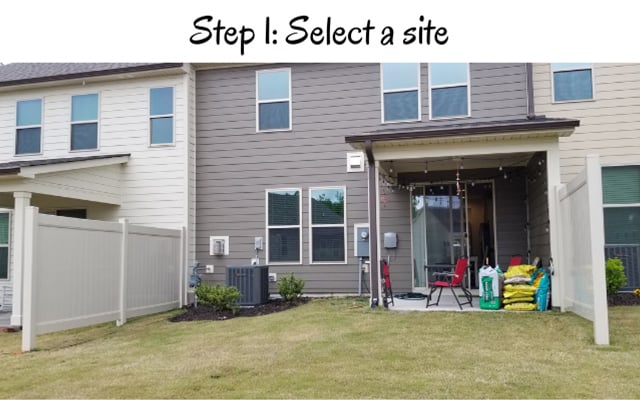
For selecting an ideal site for Dave’s raised garden bed, we took a step back to look at all the elements. Dave’s house is north facing, so naturally, the backyard would get 8+ hours of direct sunlight, which is ideal. The yard is flat with a slight slope. Their property is marked by two privacy fences on the east and west sides, which can act as windbreakers.
The raised bed could be located on the left or right of the yard. We picked the location on the left because the water housing is located nearby. This site is also tucked away from the direct view from inside, which is great because no matter how much you care, a garden is not always pretty to look at (Wait till fall, you’ll see!)
Step 2: Prepare The Site For The Raised Bed
Now it’s time to prepare the selected site.
First, ensure there are no underground utilities directly under the selected site. While you will not be digging down into the soil when preparing the site or tending to the garden plants, if there should ever be a problem with the buried utility lines, your raised bed garden may have to be removed.
Next, use a spray paint to mark off the boundary similar to the raised garden bed’s size by spraying the ground.
Now, mow the grass, remove any shrubs, tree roots, and large rocks. Use a shovel to loosen the native soil down to the depth of 6-inches. This will improve the drainage in the raised bed and enable plants to grow deeper roots. Root vegetables like carrots, turnips, and potatoes will grow better when you take time to break up the native soil in the garden bed.
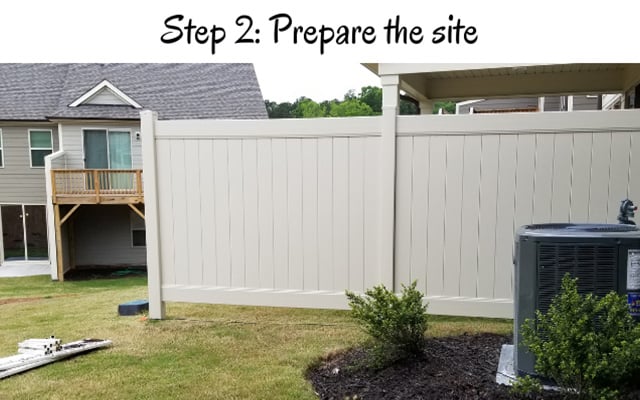
In Dave’s backyard, a new utility cable was not buried yet. So, we just moved the cable aside. Since Dave family is new to gardening, we did not have the gardening tools needed to remove the sod or dig under the raised bed. Fortunately, the raised bed they were setting up was 11” tall. That’s plenty of depth for growing vegetables, even for growing carrots and radishes. We bypassed removing the sod or digging the ground and got started on assembling the raised garden bed.
Step 3: Set Up The Raised Garden Bed
Before assembling a raised bed, first, consider the dimensions of the raised bed. The raised garden bed should be at least 6-inches high to provide enough soil space for plant roots to develop. The width should be no more than 4-feet, so it’s easy to reach across from either side.
The most recommended size of a raised garden bed for the beginner gardener is 4’ x 4’. Other popular configurations are 3’x6’, 4’x8’, and 4’x12’.
The length and actual height are up to your personal preference and available space.
Follow the instruction on the Raised bed kit to assemble the raised bed.

The Dave family was using a hand-me-down vinyl raised bed that was gifted by a friend. Even though the raised bed was used for years in their friend’s garden, it was sturdy and completely intact.
Like most of the raised bed kits available in the market, this raised bed was made up of 4 side panels and 4 corners. To assemble the raised bed, all we needed to do was slide corners and panels to create a square. Building a raised garden bed cannot be easier than this!
We started with one corner, slid one of the panels in the corner. Next, slide another corner on the panel. Before moving on to the next side, we made sure the first side is parallel to the fence behind the raised bed. Then, we repeated the steps to create a perfect 4’x4’ square.
Step 4: Line The Bottom Of The Raised Garden Bed
The bottom of the raised bed needs to be lined with material that blocks weed growth through the raised bed. This will prevent weed seeds from germinating so vegetable plants will not have to compete with weeds for nutrition and moisture. No weeds in the garden also mean less work for you.
You can use landscape fabric, recycled cardboard, or cloth fabric from recycled clothing. You should avoid lining the bottom with plastic or other non-porous material because it will prevent easy water drainage and hinder the development of a healthy worm colony in the soil.
Line the bottom of the raised bed with the selected material.
Next, if you are using landscaping fabric or recycled cloth, it is a good idea to add 2-4 inches of dry leaves, grass clippings, or other organic matter. This will help fill up the planting bed and slowly decompose and increase the soil’s fertility. The organic matter will also help smother any weed seeds that can pass through the bottom liner and germinate.
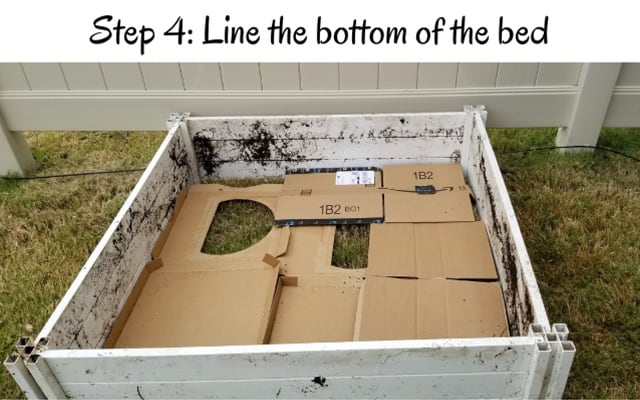
We used empty Amazon packaging boxes and pizza boxes to line the bottom of the raised bed. Over time, the cardboard will decompose and add organic matter to the soil.
Step 5: Prepare Soil For The Raised Garden Bed
Good soil is the most critical ingredient for a productive vegetable garden. You can fill a raised garden bed with any blend of soil you want to make it far superior to the native soil in your garden.
A soil blend that’s loose, nutrient-rich, and contains plenty of organic matter allows the plant roots to easily penetrate the soil. Hence, the roots have easy access to water and vital nutrients. Adding Perlite to the soil mix will help promote good drainage and air circulation.
Special Soil blends mixed for use in raised bed gardening can be purchased at any garden supply center. These pre-blended soil mixes will take the guess-work out of this step, but it will cost more than creating the soil mix yourself, and the ingredients might not be in the proportions you want.
Custom Raised bed Soil Recipe:
Create a soil blend that is 50-percent potting soil or topsoil, 30-percent compost, and 20-percent Perlite. Depending on the type of vegetable you plan to grow, you may need to add a little sand to the soil blend.
Mel Mix Soil Recipe:
The most post popular soil mix recipe is to mix each of the below ingredients in an equal amount:
• One-third of Peat moss
• One-third of vermiculite (or Perlite)
• One-third of Compost (A blend of multiple types of compost works the best)
Add the soil blend on top of the bed liner and organic matter until it is 2-inches below the top rim on the bed frame. Gently level the soil, water it thoroughly, and allow it to sit overnight before planting.
Enhance the soil with additives:
In my top 10 tips for vegetable gardening, one of the most critical is ‘Invest in the soil’. In addition to using the custom or Mel Mix recipes above, add soil enhancers to improve the raised bed garden’s productivity.
The two most essential soil enhancers are:
– Worm Castings: Also known as ‘vermicompost’, these earthworm droppings are the best soil additives for any indoor or outdoor garden. Mix 1 cup of worm castings per 4 sq ft. of raised bed soil.
– Rock dust: This is a fine powder of minerals that contains many trace elements. Rock dust enhances the soil’s productivity and provides nutrients to the vegetable plants to make the produce sweeter and better tasting.
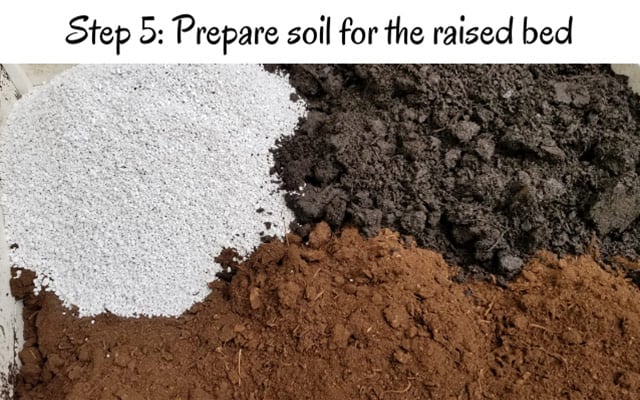
In Dave’s raised bed, we chose the Mel’s mix recipe above. We mixed Peatmoss, Perlite, and a blend of Mushroom compost and Cow manure. Using a large shovel, we mixed the ingredients thoroughly, ensuring there are no large lumps or pockets of unmixed soil.
We filled the raised bed up to the top of the raised bed because we knew this soil mix will settle down a little once wet. Mr. Dave leveled the soil before drenching it with water.
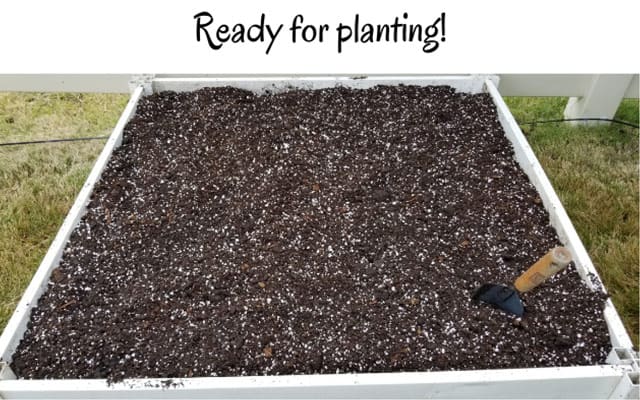
This entire process took about 1.5 hours for us from start to finish. Most of the time was spent mixing the soil components.
The result was a light and fluffy soil mix that is ideal for growing vegetables. The raised garden bed was ready for planting!
What’s next?
Now your raised garden bed is ready for vegetable planting. But what do you plant in the raised bed? How many vegetables? How far apart? I will address all those questions in the next article about What and How to plant in a raised vegetable garden bed.
Check out this article to learn how to prepare the raised bed for spring planting.
Conclusion
Even if you do not have a lot of space or time for gardening, you can still have a productive vegetable garden using the raised bed gardening method. A raised garden bed allows you to grow vegetables almost anywhere and in any soil condition. Plus, you can produce a lot more food in a raised bed than in a traditional in-ground garden. Setting up a raised bed for vegetable gardening the most challenging and critical part, but with the right location, material, and soil, you too can start growing amazing veggies in your own backyard.
Did you find this information helpful? Share the link to this article on your Facebook page or gardening group. Your fellow gardeners will thank you for it!
Questions? Comments? Want to help?
If you have a question or like to share your thoughts on this article, please leave a comment below. I will respond as soon as I can.
Pin this post for a visual reminder
Would you like to refer to this article frequently? Just pin this image to one of your Pinterest gardening boards so that you can easily find it later when you need it.
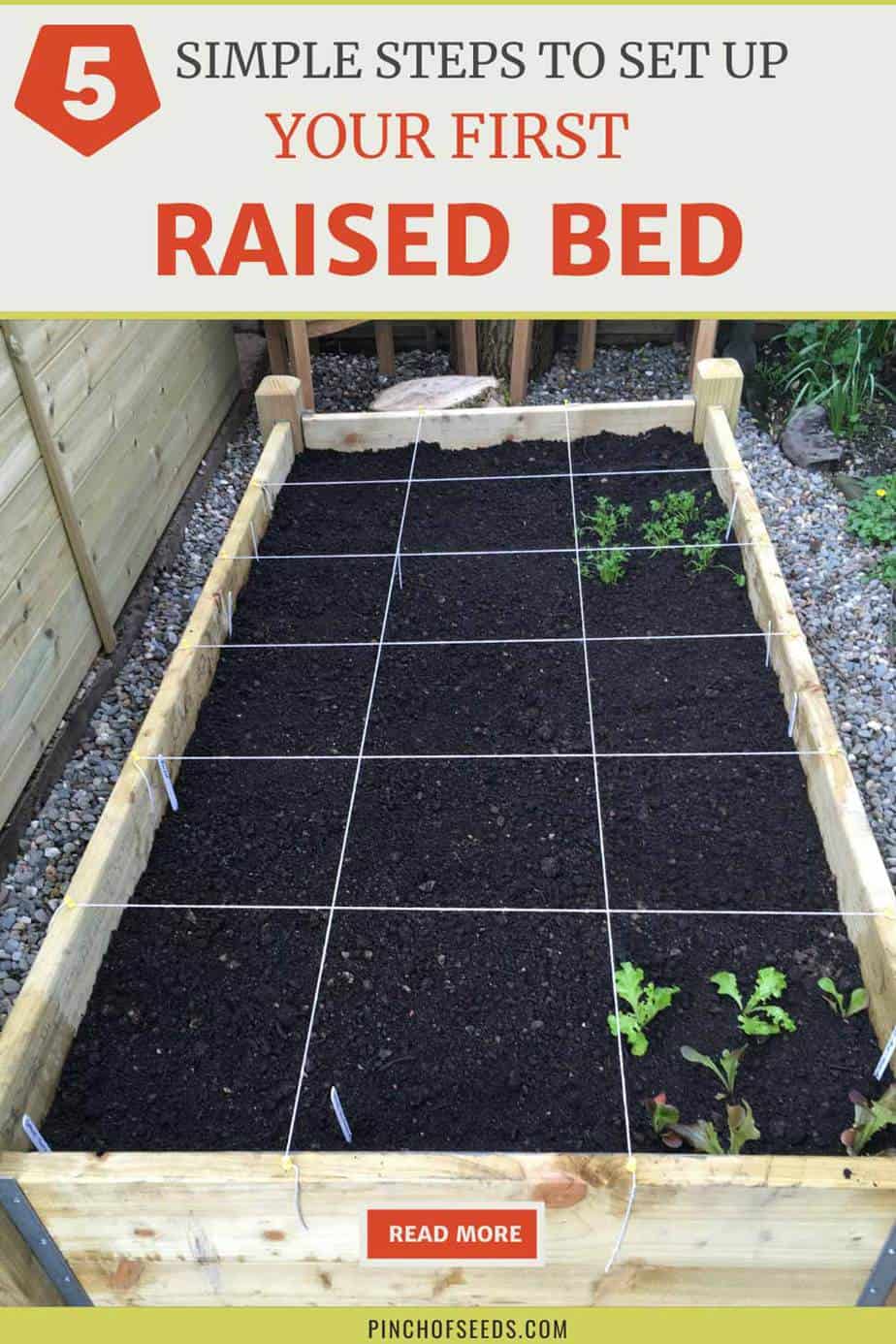
Share this with your friends:
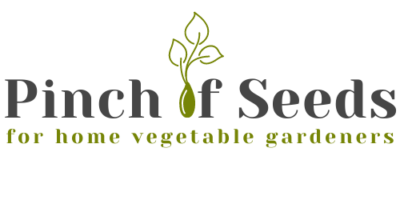
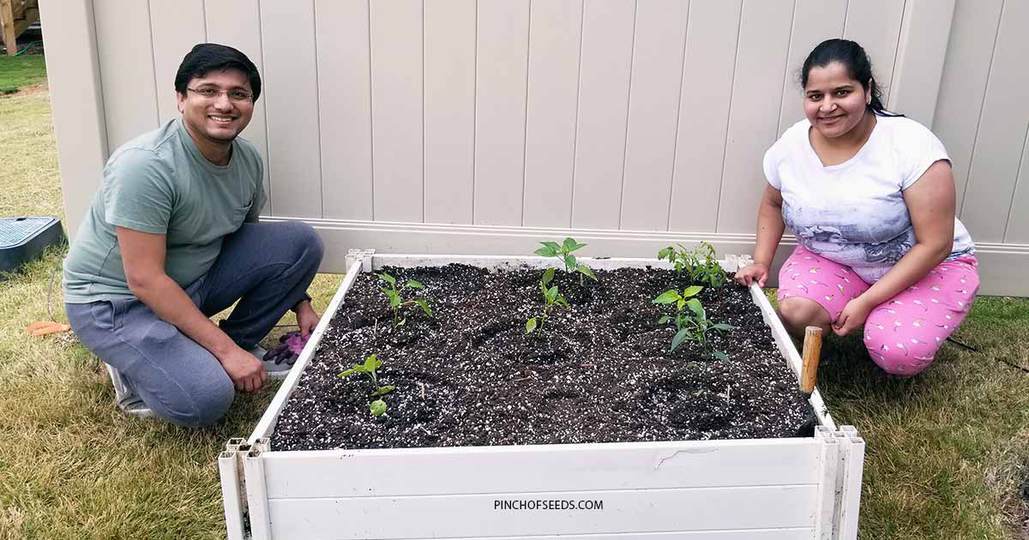
Please I need help planting my garden, how many plants do I need per square feet? I have two, 2 x 6 raised bed. I want to plant tomatos, jalapeño peppers, lettuce, peas, strawberry, yellow squash … any help is so welcome!
thank you in advance
Hi Gisela! Tomato plants need at least 2 sq ft, 3 to 4 is ideal. Pepper plants need 1 sq ft. You should plant tomatoes and peppers on the back and lettuce, peas and strawberries on the front (towards the sun). This way, the tall plants will not shade out the smaller plants growing in the front.
Yellow squash plant is probably too big for this size of the garden, unless that’s all you plant in one of the beds.
Wish you happy gardening!
Gopi
Help ! Purchased elevated raised beds( on legs) this article describes raised on ground. Do I still need to put cardboard, fabric liner and dead leaves inside an elevated planter or just compressed soil?
Hello! This article about gardening in elevated garden beds may have answers you are looking for.
Happy gardening!
Gopi
I love your Blog
This was so interesting and I am learning so much to start my gardening hobby
Hi,
I am looking to get a curry leak plant or a seed. I live in the UK. Unable to get one. Can you be of help?
Thanks
Sorry, I don’t know where in UK you can buy a curry leaf plant.
Best wishes,
Gopi
Gopi, I’m so glad I found your blog! Such great information in each article and I love the pictures you include for reference. I’m in zone 4b and it’s -8 F degrees right now with 2 feet of snow, so I find joy in reading about gardening and planning for my vegetable and flower gardens. Thank you for such great articles!
Thank you for taking time to give this feedback! It is so encouraging!
Happy gardening!
-Gopi
I am a beginner to gardening with little skills. I found your blog very useful. Thanks Gopi.